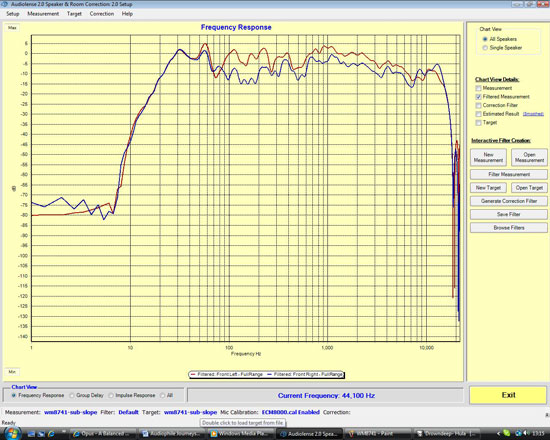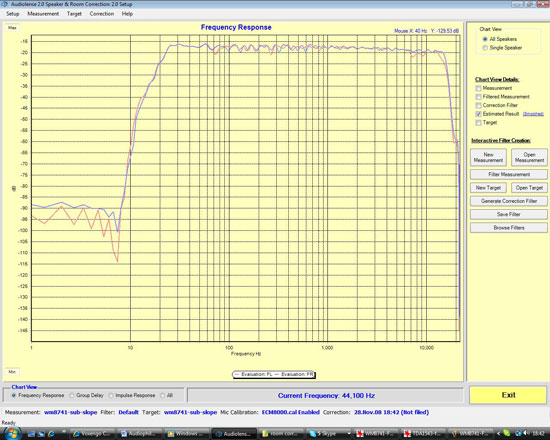Adding in the Subwoofer
The next step is to add in the subwoofer. As I'm feeding the I2S output from the PCM2707 to the TDA1543 and both Opus PCBs simultaneously, it's possible to use the TDA1543 output solely to drive the subwoofer. The Opus DACs will be used with the 300Bs and Transparence speakers maintaining a crossover-less setup for the midrange and highs.
The Linnn Isobarik 5150 is configurable to crossover between 41-81Hz in variable steps. I started off at 41Hz initially, but found that the sub gave away its corner of the room location frequently when rendering sub bass. I'm out of space in my main living room and with the Linn being quite the behemoth, there really is nowhere else for me to put it. Crossing over at 48Hz seemed better to my ears, so we'll proceed to look at the room response with the sub in place.
Opus plus Sub |
That's better; we now have a decent response to around 25Hz. The nature of the Linn sub in my room is quite "boomy" and the bass lacks definition, even with a minimal amount of gain (possibly due to placement). Crossing the unit in a little higher does help with this, but then things get lumpy around 60Hz where there's already a peak from the main speakers. It'll be interesting to see how applying DRC will level things out.
Opus plus Sub with DRC The wonders of DRC - a predicted near flat in room response between 25 Hz and 15 KHz. |
Now we're talking! A predicted response most of us dream of at the listening position. The correction file was hastily loaded into Convolver and a few tracks played to see how things sounded. At the risk of sounding like a salesman, I can tell you I was pretty knocked out by the results. The integration of the subwoofer is almost seamless, only hinting at its location on the very lowest notes. All the perceived boom factor from the bass is gone. What remains is the tightest, most articulate bass I've heard outside using my Sennheiser headphones. I already knew the Supravox drivers in open baffles had real promise, but armed with DRC and a subwoofer, they simply move up to another league.
Switching DRC on and off is pretty much a day and night change. Listening without the filters is almost torturous when you've been subjected to what is possible. It's not that things get fatiguing; it's just that everything sounds chaotic and bloated without DRC to correct the abnormalities. The sonic quality of both DAC kits combined with a PC as the feed has surpassed my expectations, far in excess of what I can recall from the HDA Xplosion card I dismissed as lackluster in my previous attempts of using a PC based front end.










114 Comments
View All Comments
mindless1 - Monday, December 1, 2008 - link
The fact is, even audio streams that measure the same can and do still sound different. The problem is the resolution of measurement and the misconceived notion that the brain interprets sound at a fixed interval as measured.There's a lot of snake oil in the audiophile world, but there's also a lot of what you'd like to call "magic" only be cause you don't accept it as non-magic.
Any decent DAC would in idealized theory be as good, but in practice a different IC topology may lend itself better to certain inherant localized noise frequencies and cutoffs, be better mated to the circuit it's dropped into, have drifts from thermal changes, etc. If they were all the same why would there be so many? I will agree that which modern DAC is used in a reasonably good design matters less than what follows after it in the chain but the best way to minimize any potential for degradation is to start out with what is most likely to minimize it in every way possible then following this concept the entire time, waiting and seeing if the end result is audibly different rather than downplaying them all without knowing the additive result yet.
CSMR - Monday, December 1, 2008 - link
Yes if you are maximizing quality you will choose the best of all components. But it's more sensible to care about cost and time too, so you have to prioritize. The value of the research about the unimportance of DACs (at at beyond a certain level) is that you can stop worrying about this part of the chain and spend you time/money where it is important.JonnyDough - Tuesday, December 2, 2008 - link
Exactly my point. Why spend more on one component if it's going to be "bottlenecked" by another one. Spending $2000 on a nice amp is crazy if your other components are crap. I think in the end it's like all other techs. You want decent stuff for a reasonable price unless you have more money than brains. While I scoff at people willing to spend more than few thousand on a sound system, without them we wouldn't have gotten to where we are today - with good possibilities on the market. As long as you like what you hear, who cares if it's perfect? At one point is something "good enough?" I mean honestly, there are people starving in the world, friends dying of cancer, etc...and we want to worry about whether or not something is inaudibly "perfect." Blow your money on something that MATTERS, you can't listen to music every hour of everyday unless your job is singing.CSMR - Tuesday, December 2, 2008 - link
I meant you can spend time/money on speakers/room acoustics/dsp but food for starving people is admittedly a better use of time and money.JonnyDough - Wednesday, December 3, 2008 - link
That's actually a matter of perspective. For example, you can donate food to a starving kid in some third world country and next thing you know that child has three kids and no way to feed them - and you've just marginally made the problem worse, not better.I think money is better spent on education, which leads to fewer babies. Many countries do not have quality farmland that can support the population on their own (the U.S. supports a large percentage of the world's population). Then there's natural habitat destruction, pollution from oil for having to ship food to them, etc. You get the picture.
JonnyDough - Monday, December 1, 2008 - link
While I was generally agreeing with CMSR above, I guess what everyone ends up saying is that hearing is subjective, which is something audiophiles are always agreeing upon yet they still love to argue over things.Does a vinyl record produce better sound than a CD?
It depends on what an individual values most.
A CD may produce less static noise, but have a "duller" sound, seemingly less highs and lows. It all depends on what one appreciates with their own ears.
While there are measurements that can be taken in a closed chamber, one sound system might actually sound better in a specific home or room than another for whatever reason. Even so, the average person can rarely tell a difference these days between the moderately priced components.
The really silly thing is that people will spend $200 on a sound card and then use cheap plastic speakers.
Rajinder Gill - Monday, December 1, 2008 - link
Lol, it's ok, everyone in entitled to have their say.It's the first piece so bear with us while we try to cater to a wider set of ideals.
With regards to the obj/subj stuff, it's an argument that'll never be solved.
later
CSMR - Monday, December 1, 2008 - link
Sorry if I came on too strongly; I was just expecting that Anandtech would have not necessarily an expert take but at least a more technical take than you get in audiophile communities.I would do some more fundamental thinking about what are the key factors in computer audio playback.
As a start you could rank in terms of what is most critical:
computer performance, computer quietness, software (drivers, dsp), analog line out, volume control, amplification, cables, speakers, room acoustics.
I won't give you my list but you should think about it and it is possible to compare many of these things in a very quantitative way, and some are more important than others by several orders of magnitude.
AnnihilatorX - Monday, December 1, 2008 - link
A dumb question about correction.The theory behind it is simple enough, but why do we need dedicated hardware to do the correction? Why can't we use simple graphical equalizers? I understand graphical equalizers are quite discrete in the range of selectable frequencies. How much difference does it make?
Rajinder Gill - Monday, December 1, 2008 - link
DRC - ease of use and range of control, plus taking care of things in the digital realm rather than in the analogue.You could fudge some control with a multi band digital equaliser and the means to measure the response, but it'd be damn tedious and utimately limited.